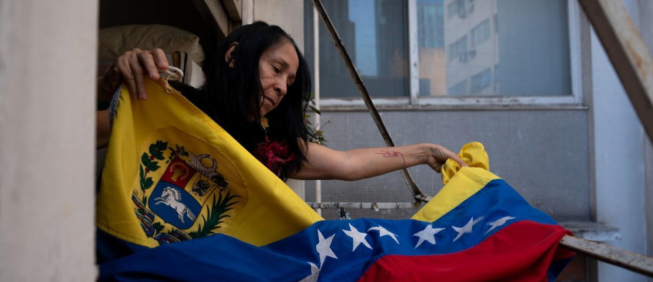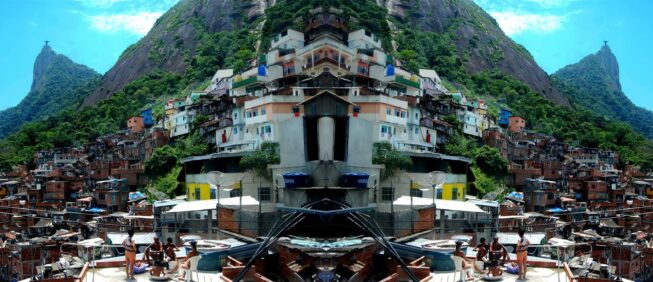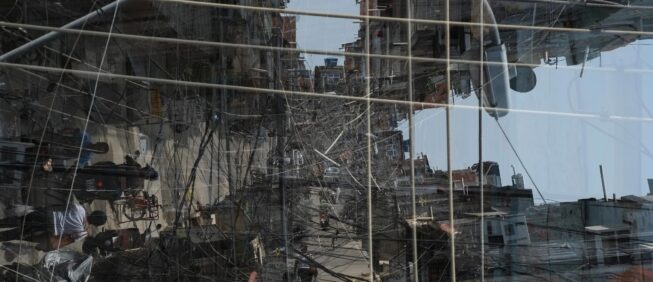Daniel de Souza: Between Loves and Quilombos in the Black Amazon
One of the main quilombola leaders in the State of Pará, Daniel salvages the saga of his ancestors that inhabited the region of Erepecuru and tells us how their lives helped to paint the Amazon Black
Raquel Paris
| Brazil |
13 de August de 2020
translated by Stephanie Reist
To tell this story, we need to go back 200 years. More precisely, we need to go back to the second half of the 18th century, when the first men, women, and children of bantu origin, coming primarily from Angola and the current Democratic Republic of the Congo, were brought to the livestock and cacao plantations in the State of Pará. In the middle of colossal forests, rivers so large that you cannot see the other side, and a widespread indigenous population, some managed to escape the captivity of enslavement by navigating the vast waters of the Trombetas River, a tributary of the Amazon River. Taking advantage of the waterfalls as defense, they hid in the jungle for over 100 years, only emerging once the Golden Law was signed1 The Lei Áurea or Golden Law emancipated all enslaved peoples in Brazil and was signed on May 13, 1888 by Princess Isabel.. This is the story of one of their descendants.
Daughters and Sons of Erepecuru
Those who have already navigated the Trombetas River, located in the State of Pará in the North of Brazil, know that it can be divided into two parts. The first are the rough waters, difficult to maneuver, home to waterfalls and indigenous nations and the perfect hideout for those who fled slavery. The second part consists of calm waters and “black land (a name announcing the presence of former indigenous inhabitants), today dotted by quilombola (the descendants of run-away enslaved people of African-descent) communities that took root there during the 19th century. It is a disputed area between these quilombola communities, mining companies, and federal environmental preservation agencies—the Biological Research of Trompetas and the National Saracá-Taquera Forest.2 According to Euripedes Funes in his article “Comunidades Mocambeiras do Trombetas.””
It is in this place of conflict that we find the quilombola territory of Erepecuru. Made up of 12 communities, including the Jauary quilombo, the home of Daniel de Souza, 62 years old, 30 of which have been dedicated to the struggle of quilombolas in the State of Pará. One could say that Daniel was planted there by his great-grandfather, who escaped slavery along with three other families. It is with this fact, this cosmic turn in the lives of his ancestors that reaches out to and defines the living, that Daniel begins his narrative:
“This quilombo has existed since the end of the 18th century, beginning of the 19th, when quilombolas fled slavery and hid themselves among the waterfalls. Only four families fled, and they were not followed because of the Chuvisco Waterfall, which saved them. It is a very tall waterfall, reaching 80 meters tall in the summer. It has three cascades in a single spot, a very fantastic place. And they hid and stayed there. There are traces of our archaeological site, a very beautiful thing. Today the quilombo is beneath the waterfalls, in the calm waters, without cascades. They have been there since 1901. In 1889, they came and celebrated the end of slavery under the shelter of the rock. Have you ever thought about spending 100 years in the jungle?”
And they were not alone. On February 22, 1873, the newspaper “Baixo Amazonas” of the city of Santarém, documented the constant flight of enslaved people. The report serves as evidence of the prevalence of slavocratic and racist thought:
Despite the lack of manual laborers faced by the agriculturalists of the Amazon, exacerbated by mass emigration to the rubber plantations of Alto Amazonas, we even have to deal with the continuous escapes of slaves on a daily basis, abandoning their masters to settle in the quilombos of Trombetas, in Óbidos, and Curuá, in Alenquer. The number of slaves that inhabit these two jungle hide-outs has grown, according to trustworthy calculations, to more than a thousand. We have not found another way to snuff out the quilombos, since measures already undertaken by the government have proven ineffective in its missions to beat the run-aways.
These “missions to beat the run-aways” comprised the topic of the first conversation that Daniel had with his grandfather, Ricardo Melo, about the period of slavery. At the time, he was 11 years-old and he had never heard anyone speak about this issue: “I don’t remember the day, it was a Saturday, if I’m not mistaken, in January of 1969. I was hunting with my grandfather, and it was the first time I saw him speak about slavery! I became very emotional, but he even more so,” he recalls.

“We are great victors. Our ancestors escaped slavery and resisted”
Daniel says that, during the hunt, his grandfather forgot his saber in the forest. Upon arriving at home, while breaking open nuts, Ricardo remembered the saber, bringing forward his memories of slavery: “I remembered slavery just now. When our grandfathers fled here they lost things, and when they did, they did not turn back to get them. They went deeper into the brush to hide far away and they did not go back to get what they had forgotten,” Ricardo explained. Later, the grandfather would ask him to keep the conversation a secret; it would only be repeated decades later.
This was not their only strategy to avoid the run-away slave patrols and remain in flight. To ensure that they did not return, Daniel’s ancestors strategically constructed the quilombo on elevated territory, and they maintained alerts to put their escape plans into action whenever a threat arose.
“They brought from Africa this power to cure, this power to see invisible things, to know what could happen. They were trained like this: Guilherme, my great grandfather’s brother, was trained to row with abandon, so when someone followed them, they had a way to get out quickly. The sites had strategic locations from where one could see a great distance. So there was the person who rowed, the person who could hear well if someone was coming from afar, and another that could smell well, who had a good nose, who was trained to detect the smell of fire. This happened a lot among them, this training. They did not work a lot. Instead they kept a lookout for whomever might be coming to take them back to slavery, and that’s what primarily happened,” he explained.
“In that period, Black people stayed in the jungle for nearly one hundred years. How were they cured? They learned from the Indians”
But it was not only the skills learned in the quilombo’s trainings and those brought from their lives before slavery that kept these people free. Throughout colonial history, we see an important key to survival repeated: the alliance between the indigenous peoples of Abya Yala (the present-day Americas) and the peoples forcefully taken from the African continent. The ability to recognize healing plants was one of the forms of knowledge they exchanged. As masters of the territory, indigenous peoples mapped out rivers, streams, waterfalls, and safe routes throughout the forest. Their encounters were not always easy and some were not at all friendly; nevertheless, this alliance determined the success of escapes from slavery, and, more importantly, for the permanence and longevity of the quilombos.

Quilombola Principles and Education
The mark of slavery ran through various generations and even reached Daniel’s infancy. It was a habit among the children, whenever they heard the sound of a motor, to hide in the brush, and mothers would claim the arrival of a stranger to interrupt children’s games. But, according to him, none of this was stronger than the joy of having been born in a quilombo. A permanent happiness underpinned by the abundance of the hunt, food, and affection. This self-sufficiency allowed Daniel, for example, to go ten years without going to the city of Oriximiná.
“How beautiful life was in the quilombo! The unity, the love, the solidarity truly worked! Respect for elders, asking for the blessings of elders. Being a quilombola is not something you just claim. You have to show it through principles.” For Daniel, education creates the conditions for the maintenance of his people’s principles, but he warns, not just any education! He insists on an education that comes “from within the home” that teaches love, solidarity, respect for nature, and pride in one’s history.
“History that was told to people through books at that time is a completely different history. Today we are reconstructing a new history, taking it to schools, so that we can understand our true history. How things were, why we fled, why we hid. Nobody likes to be a slave.”
He continues to emphasize another aspect of education: the construction of his people’s social memory. The circuits of memory that began before slavery constitute a constellation of information that connects his community’s past and the present. These circuits reinforce and expand identity and the ties of belonging with oneself, with the other and with the territory. Quilombola memory, therefore, belongs to everyone and no one. The youngest learn from the elders and, in this way, these circuits are constantly re-lived and re-nourished: “My grandfather, for example, was my professor, my aunt who died at 92 years old; my mother, who is 83 years old, has much history to tell us and only true history.”
“The Quilombo, for us, then in the past and today, is a school”
“True” history and “told ”history are binomials that appear recurrently throughout his narrative. Daniel constantly highlights the difference between true history—recounted by his ancestors—and told history—found in books. For him, who did not go to school and had his mother as a teacher, appealing to these categories legitimizes his narrative before his own group and in the face of visitors who come to the territory. “At that time, our history was told in a very sad way, which treated us as if we weren’t human. I remember when I started to study, in 1969, from a book called ‘Brazilian Infancy.’ I read that book... Black people working as slaves, and this was said casually, you know. For this, that was something super simple and today we are reconstructing a new history; this is very important in the current political context in Brazil and we have been telling our true history,” he underscores.
The passing of time has brought many complexities to the maintenance of quilombola education and its principles. Daniel asserts that contemporary points of view should be considered but “without forgetting that beautiful past that we had of unity and love.” In the end, it was through strengthening their collectivity that they won the political organization of their territory.
The Preservation of the Forest and Self-Organizing: A Quilombola Inheritance
Today, the self-organizing of Quilombo Erepecuru occurs through the residents’ association that brings together two representatives from each of the 12 communities in the quilombola territory. And there are many challenges: loggers, illegal mining, government hydroelectric projects, forest management undertaken without consulting quilombola communities. Nevertheless, resistance and mobilization constitute the history of the Erepecuru quilombolas, and, most recently, this has resulted in the collective land-titling of its lands, one of the first to follow this model in Brazil.
“A way to better unite the people is through the association. The most important thing, for us, is that it is organized to ensure the autonomy of the communities and not to enter a relationship of dependency. We have an internet collective; this is an important thing. It’s a collective that the community has and it’s the only one that does.”
Another key aspect of the Jauary Quilombo’s sociopolitical organization is the preservation of the forest. To this end, Daniel’s forebearers developed an ingenious strategy that is still used by their descendants today: baptizing the Brazil nut trees with the names of their ancestors. “There is a cluster [of trees] with my father’s name, Francisco Melo; there is Lautério, who was my great-great-great grandfather; there is the tree of my grandfather, named Ricardo Melo; way up there my great grandmother named Senhorinha also has a spot named after her; after my uncle, my dad’s cousin, there is a tree called Uncle Modesto [modest]. In this way there are many things that existed in the past that keep our social memory for us.”
The preservation of the forest has also come with a few indispensable self-organizing lessons: how to cultivate plots “on the edge of consumption,” demonstrating the sophisticated calculation between food security and protecting the forest that the quilombolas have developed. “During that time we only worked collectively, doing collective projects, puxirum as we called it, and the work was always divided with the plots right next to each other. The unity among the elders was very strong,” Daniel describes.
By knowing how to read, write, and due to his significant political activism, Daniel is one of the main leaders of the territory. The many materials, photos, and videos of him give an idea of his importance in the fight for quilombola rights in the Amazon. Soon, his marvelous trajectory will be turned into a book.
“Being a quilombola is not simply saying that you are a quilombola and then forgetting everything after graduating from university, especially the principles of respect, collectivity, love, solidarity. There are the principles of the quilombo that should never be forgotten; even if they only function within the territory, they are very important so that today we can maintain our identity. This is quilombola identity: maintaining the principles of respect.”

Raquel Paris | Brasil |
Journalist and Communication Coordinator at UNIperipheries
raquel.paris@imja.org.br







